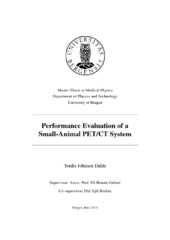Performance Evaluation of a Small-Animal PET/CT System
Master thesis
Permanent lenke
https://hdl.handle.net/1956/8546Utgivelsesdato
2014-06-02Metadata
Vis full innførselSamlinger
Sammendrag
This master project is the first vendor-independent performance evaluation of the new nanoScan PET/CT system at the University of Bergen. A comprehensive performance evaluation of a novel scanner is very important, particularly when quantitative assessments of images are required. The nanoScan PET/CT system is a fully integrated small-animal PET/CT system. An abbreviated performance evaluation of the CT subsystem was done, which included a Hounsfield quality check, a comparison of reconstruction filters and an evaluation of the different scanning methods. The PET subsystem was performance evaluated according to the NEMA NU 4-2008 standard. This standard includes tests of spatial resolution, counting rate capabilities, sensitivity and image quality. The CT evaluation proved adequate for its intended use. There were only minor differences in the noise measurement of the different reconstruction filters. The scanning method helical, 1 pitch" would for most applications be recommended, as this scanning method had lowest dose, good images, and just few minutes longer scan time than the scanning method with lowest scan time. The measurements from the PET evaluation were in good agreement with values reported by vendor and in literature. The evaluation of the scanner shows that it has one of the best spatial resolutions available, approximately 1 mm at center of field of view (FOV). The sensitivity at center of FOV was 8.8%, just a bit lower than the highest reported absolute sensitivity at center of FOV, i.e. 10%. The counting rate capabilities proved adequate for all applications undertaken to date, and the NEMA image quality phantom studies demonstrated good values of uniformity and recovery coefficients. The procedures and methods in this thesis will make it easier to monitor the scanner performance with periodic testing to check if the scanner is robust, reliable and reproducible.
